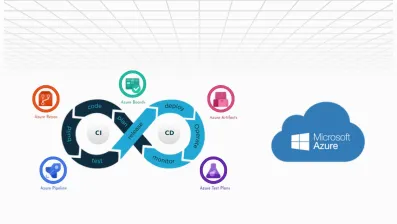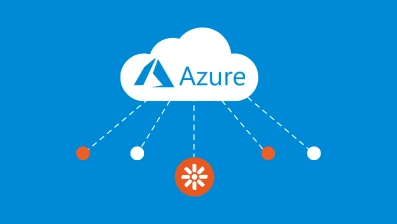Cloud adoption is no longer a tech upgrade; it’s a business transformation. But moving to the cloud isn’t just about lifting servers or shifting data.
It’s about reshaping how your organization operates, scales, and competes. That’s where the Azure Cloud Adoption Framework (CAF) makes a difference.
Developed by Microsoft, CAF is a clear, structured guide that helps businesses turn cloud goals into real results.
Whether you're starting fresh or optimizing what’s already in place, this framework connects strategy with execution, one step at a time.
It removes the guesswork and brings clarity, control, and momentum to your cloud journey. If you're serious about doing cloud right, CAF is your starting line.
Let’s get into the blog to know about it all.
What is the Cloud Adoption Framework?
The Cloud Adoption Framework is a set of best practices, tools, and guidance developed by Microsoft to help organizations move to the cloud with confidence.
It provides a structured approach to planning, migrating, and managing cloud environments effectively.
If you're asking what is Cloud Adoption Framework is,"—it's more than just technical documentation.
It acts as a strategic blueprint that connects your business goals with cloud capabilities.
The Azure Cloud Adoption Framework guides you through every phase — from defining your strategy and preparing your team, to managing, securing, and optimizing your cloud setup.
By following this framework, businesses can reduce risks, improve efficiency, and maximize the value of their cloud investments.
It’s designed to support companies at any stage of their cloud journey.
Key Phases of the Azure Cloud Adoption Framework
The beauty of the Azure cloud adoption framework architecture lies in its methodical, phase-based approach that breaks down the seemingly monumental task of cloud transformation into manageable, sequential stages.
This architectural design isn't just about following a checklist—it's about building momentum and capability at each stage that naturally leads to success in the next.
What makes this framework particularly powerful is how each phase builds upon the previous one, creating a compound effect of knowledge, skills, and organizational readiness.
The Azure cloud adoption framework architecture ensures that you're not just implementing technology, but building a sustainable foundation for long-term cloud success.
Let's explore each transformative phase that will guide your organization from cloud curiosity to cloud mastery:
1. Strategy Phase: Defining Your Cloud North Star
The Strategy phase is where vision meets reality. This isn't about dreaming big—it's about dreaming smart.
Here, you'll define the business justification for your cloud journey, establish clear success metrics, and create a compelling narrative that will sustain your organization through the inevitable challenges ahead.
Key Activities:
Business Outcome Definition: Identify specific, measurable business outcomes that cloud adoption will enable
Financial Planning: Develop comprehensive cost models, ROI projections, and budget frameworks
Cloud Strategy Alignment: Ensure your cloud strategy supports and amplifies your overall business strategy
Stakeholder Engagement: Build a coalition of sponsors and champions across the organization
Risk Assessment: Identify potential roadblocks and develop mitigation strategies
Success Indicators:
Clear, quantifiable business case for cloud adoption
Established success metrics and KPIs
Secured executive sponsorship and budget approval
Documented risk mitigation strategies
2. Plan Phase: Blueprinting Your Cloud Journey
The Plan phase transforms your strategic vision into actionable roadmaps.
This is where the rubber meets the road—where abstract concepts become concrete timelines, resource allocations, and deliverables.
A well-crafted cloud adoption plan serves as your project's GPS, keeping you on track even when the journey gets complex.
During planning, many organizations also evaluate multi-cloud strategies and compare platforms like Azure vs AWS, vs Google Cloud to choose the best fit for their operational and compliance needs.
Key Activities:
Digital Estate Assessment: Comprehensive inventory and analysis of current IT assets
Cloud Adoption Plan Development: Create detailed project plans with timelines, milestones, and dependencies
Skills Readiness Assessment: Evaluate current team capabilities and identify training needs
Change Management Planning: Develop strategies for managing organizational change
Governance Framework Design: Establish policies, procedures, and controls for cloud operations
Success Indicators:
Comprehensive understanding of the current IT landscape
Detailed project plans with realistic timelines
Identified skill gaps and training programs
Established governance framework
Clear communication and change management strategies
3. Ready Phase: Preparing Your Cloud Foundation
The Ready phase is all about establishing the foundational elements that will support your cloud workloads.
Think of this as building the infrastructure for your cloud city—everything from the basic utilities (networking, security) to the governance structures that will ensure sustainable growth.
Key Activities:
Landing Zone Setup: Configure foundational Azure infrastructure and services
Security Framework Implementation: Establish security baselines, identity management, and access controls
Network Architecture Design: Plan and implement connectivity, segmentation, and traffic management
Governance Implementation: Deploy policies, compliance frameworks, and monitoring systems
Skills Development: Conduct training programs and hands-on workshops
Success Indicators:
Operational Azure landing zones
Implemented security and compliance frameworks
Established network connectivity and architecture
Deployed governance and monitoring systems
Trained and ready technical teams
4. Adopt Phase: Executing Your Cloud Transformation
The Adopt phase is where the magic happens—where your careful planning and preparation translate into actual cloud workloads and business value.
This phase typically involves two distinct but complementary approaches: migrating existing workloads and innovating with cloud-native solutions.
Migration Activities:
Workload Assessment: Evaluate applications for cloud readiness
Migration Execution: Systematic movement of workloads to Azure
Application Modernization: Optimize applications for cloud environments
Data Migration: Secure and efficient transfer of data assets
Testing and Validation: Comprehensive testing of migrated workloads
Innovation Activities:
Cloud-Native Development: Build new applications designed for cloud environments
Modern Data Platform: Implement advanced analytics and AI capabilities
DevOps Integration: Establish CI/CD pipelines and automated deployment processes
Microservices Architecture: Decompose monolithic applications into scalable services
Serverless Computing: Leverage Functions, Logic Apps, and other serverless technologies
Success Indicators:
Successfully migrated workloads operating in Azure.
Improved application performance and scalability
Reduced operational costs and improved efficiency
New cloud-native solutions delivering business value
Established DevOps practices and automated processes
5. Govern Phase: Ensuring Sustainable Cloud Operations
The Govern phase ensures that your cloud environment remains secure, compliant, and cost-effective as it scales.
This isn't a one-time activity but an ongoing discipline that evolves with your organization's needs and the changing cloud landscape.
Key Activities:
Policy Management: Implement and maintain Azure Policy for consistent governance
Cost Management: Establish budgets, alerts, and optimization processes
Security Monitoring: Deploy continuous security monitoring and threat detection
Compliance Assurance: Maintain adherence to regulatory and industry standards
Resource Optimization: Continuously optimize resource usage and costs
Success Indicators:
Implemented governance policies and automated compliance
Controlled and optimized cloud costs
Maintained security posture and compliance status
Established processes for continuous improvement
Clear accountability and responsibility structures
6. Manage Phase: Optimizing Cloud Operations
The Manage phase focuses on the day-to-day operations of your cloud environment, ensuring that your cloud investments continue to deliver value while maintaining high availability, performance, and security standards.
Key Activities:
Operations Management: Establish monitoring, alerting, and incident response procedures
Performance Optimization: Continuously tune applications and infrastructure for optimal performance
Business Continuity: Implement backup, disaster recovery, and business continuity plans
Service Management: Establish service level agreements and performance metrics
Continuous Improvement: Regular review and enhancement of cloud operations
Success Indicators:
Stable and reliable cloud operations
Proactive monitoring and rapid incident response
Optimized performance and cost efficiency
Established business continuity capabilities
Continuous improvement processes and culture
Advanced Considerations and Best Practices
To get the most from your cloud journey, follow proven Azure Cloud Adoption best practices like automated governance, cost management, and security hardening.
These strategies help you scale efficiently while keeping control and visibility across your environment:
1] Cultural Transformation
Cloud adoption isn't just a technical journey—it's a cultural one.
Organizations that succeed in the cloud embrace a culture of continuous learning, experimentation, and adaptation.
This means fostering an environment where failure is seen as a learning opportunity, where teams are empowered to innovate, and where collaboration across traditional silos becomes the norm.
2] Security-First Approach
Security shouldn't be an afterthought in your cloud journey.
The Azure Cloud Adoption Framework emphasizes a security-first approach, integrating security considerations into every phase of adoption.
Following Azure security approaches includes implementing Zero Trust architecture, ensuring data encryption at rest and in transit, and maintaining comprehensive audit trails.
3] FinOps Excellence
Cloud cost management is an ongoing discipline that requires dedicated attention.
A strong Azure cost optimization strategy helps align spending with business goals, uncover waste, and improve overall ROI in the cloud.
Successful organizations implement FinOps practices that provide visibility into cloud spending, enable cost optimization, and ensure that cloud investments align with business value creation.
4] Automation and DevOps
The cloud's true power is unleashed through automation.
Organizations should prioritize the implementation of DevOps practices, including infrastructure as code, automated testing, and continuous integration/continuous deployment (CI/CD) pipelines.
Teams can accelerate deployments by following an Azure Pipelines guide, streamlining CI/CD processes, and reducing time-to-market for new features.
Measuring Success and ROI
The success of your cloud adoption journey should be measured not just in technical terms, but in business outcomes. Key metrics to track include:
Financial Metrics:
Total cost of ownership (TCO) reduction
Return on investment (ROI)
Operational cost savings
Revenue growth enabled by cloud capabilities
Operational Metrics:
Application performance improvements
System availability and reliability
Deployment frequency and lead times
Mean time to recovery (MTTR)
Strategic Metrics:
Time to market for new products/services
Innovation velocity and experimentation rate
Customer satisfaction and engagement
Market competitiveness and differentiation
Real-World Applications of the Azure Cloud Adoption Framework
So, you've heard about Microsoft's Cloud Adoption Framework, but what does it actually look like in action?
Well, this framework isn’t just a fancy name; it’s a strategic roadmap that helps businesses like yours adopt the cloud in a secure, efficient, and cost-effective way.
Let’s explore how real companies use it to transform operations, streamline IT, and drive innovation, all while avoiding those “uh-oh” cloud migration moments.
► Retail Gets Personal
Imagine a retail brand struggling with fragmented customer data across stores and e-commerce.
Using the Cloud Adoption Framework, they migrated their legacy systems to Azure, enabling real-time analytics.
Now? They can recommend personalized offers, predict shopping trends, and make customers feel like VIPs.
All without guessing what might sell next season.
For instance, eCommerce brands running Kentico on Azure benefit from seamless scalability, real-time analytics, and global content delivery — all backed by the framework's structured guidance.
► Manufacturing Goes Predictive
A factory used to rely on reactive maintenance — waiting until machines broke before fixing them.
With Azure and the framework’s strategic guidance, they connected IoT sensors to the cloud and used predictive analytics to spot problems before they happened.
Result? Fewer breakdowns. More uptime. And a big smile from the operations manager.
► Healthcare Gets Smarter and Safer
A healthcare provider needed to digitize patient records securely.
By following the Cloud Adoption Framework, they ensured compliance with HIPAA, built secure infrastructure, and introduced telehealth apps powered by Azure.
Now doctors can access patient histories in seconds, and patients can consult from home.
Win-win for everyone.
► Finance Stays Agile (and Compliant)
A finance firm wanted to innovate fast without risking data compliance.
Thanks to the framework’s governance and risk guidance, they built an Azure-based platform with guardrails that kept sensitive info secure, even while scaling quickly.
Now they launch new services in weeks instead of months.
► Startups Launch Like Rocketships
Startups love speed. But without a clear plan, cloud costs can explode.
With the Cloud Adoption Framework, they get a structured way to assess, plan, and build — so they’re not just moving fast, but moving smart.
Azure gives them agility. The framework gives them direction.
The Cloud Adoption Framework isn’t just for IT teams — it’s for visionaries who want to scale wisely, protect their assets, and deliver amazing experiences to their customers.
And hey, it’s not all serious planning and paperwork — it's the secret sauce behind many of the digital experiences you use every day.
Common Pitfalls in Cloud Adoption Framework and How to Avoid Them?
Let’s be honest — cloud adoption sounds exciting, but it’s not always smooth sailing.
Many businesses jump in with high hopes, only to hit roadblocks that slow progress, rack up unexpected costs, or leave teams frustrated.
But here’s the good news: most of these issues are totally avoidable — if you know what to look out for.
Before you dive headfirst into cloud transformation, let’s explore the most common pitfalls companies face and how you can steer clear of them like a pro.
1. Underestimating Change Management
Many organizations focus heavily on the technical aspects of cloud adoption while neglecting the human element.
Successful cloud adoption requires comprehensive change management, including communication strategies, training programs, and support for employees throughout the transition.
2. Inadequate Skills Development
Cloud technologies evolve rapidly, and yesterday's expertise may not be sufficient for tomorrow's challenges.
Organizations should invest in continuous learning and development programs to ensure their teams remain current with cloud best practices and emerging technologies.
3. Neglecting Governance
The flexibility and agility of cloud environments can quickly lead to sprawl and inefficiency without proper governance.
Establishing clear policies, procedures, and controls from the beginning is essential for maintaining order and efficiency as your cloud environment scales.
The Future of Cloud Adoption
As we look toward the future, cloud adoption will continue to evolve, driven by emerging technologies like artificial intelligence, machine learning, Internet of Things (IoT), and edge computing.
Organizations that establish strong cloud foundations today will be better positioned to leverage these technologies as they mature.
The Azure Cloud Adoption Framework will continue to evolve alongside these technological advances, incorporating new best practices and methodologies as they emerge.
Organizations should maintain flexibility and adaptability in their cloud strategies to take advantage of new opportunities as they arise.
How DotStark Can Help You With Azure Cloud App Adoption?
At DotStark, we don’t just move your apps to the cloud — we make sure they thrive there.
As a trusted Azure development company, we bring deep expertise, tailored strategies, and hands-on support to help you adopt the Azure Cloud the smart way. From planning and architecture to migration and optimization, we turn complexity into clarity.
Whether you're starting from scratch or modernizing legacy systems, our team ensures your cloud journey is smooth, secure, and built for growth.
Ready to unlock the real power of Azure? Let DotStark guide your transformation — and make it fun along the way!
Conclusion
The Azure Cloud Adoption Framework is more than a roadmap — it’s a proven guide to help organizations thrive in the cloud era.
It offers structure, clarity, and best practices to minimize risks and unlock long-term value. Whether you're just beginning or optimizing your current cloud setup, the framework empowers you to move forward with confidence.
Cloud adoption isn’t a one-time project—it’s a continuous journey of innovation and growth. With the right strategy, preparation, and support, your organization can transform how it operates, scales, and competes. The cloud is your next big move—and your future starts now.
Frequently Asked Questions
DotStark, a leading Azure development company, helps businesses navigate every stage of their cloud journey. From planning and architecture to migration and optimization, we provide expert guidance to ensure your transition to Azure is smooth, secure, and aligned with your business goals.
Frequent mistakes include:
Ignoring change management
Failing to upskill teams
Poor governance planning
Underestimating cloud costs
Avoiding these requires early planning, training, and a solid governance strategy as outlined in the Azure Cloud Adoption Framework.
Some of the top best practices include:
Implementing automated governance
Establishing a security-first approach
Adopting FinOps for cloud cost management
Embracing DevOps and automation
Fostering a culture of continuous learning and adaptation
These help organizations scale effectively and securely.
The framework includes six core phases:
Strategy – Define goals and success metrics
Plan – Build actionable roadmaps
Ready – Set up cloud foundations
Adopt – Migrate and innovate
Govern – Ensure compliance and control.
Manage - Optimize, and operate efficiently.
Each phase builds on the last for sustainable cloud transformation.
The Azure Cloud Adoption Framework is a structured set of best practices, tools, and guidelines developed by Microsoft to help organizations adopt cloud technology efficiently and strategically. It aligns business goals with cloud capabilities, ensuring smoother migrations, improved governance, and long-term value.
_1.webp)















 +91 9680599916
+91 9680599916
 vanshika@dotstark.com
vanshika@dotstark.com
